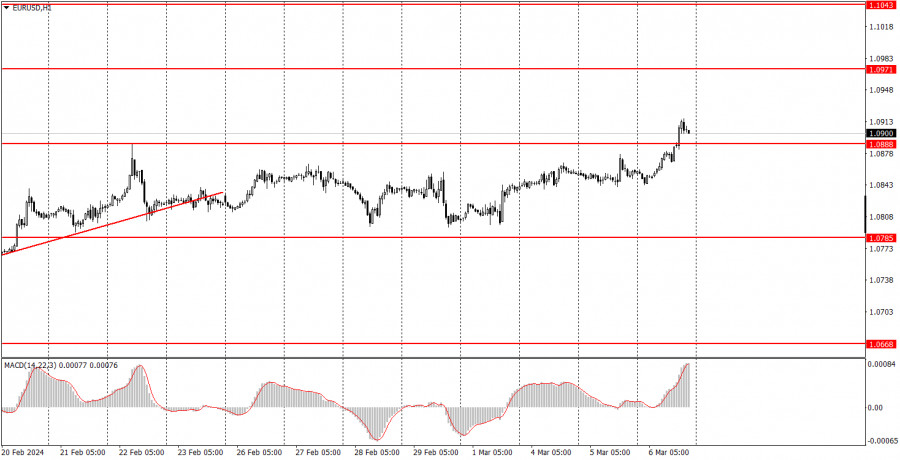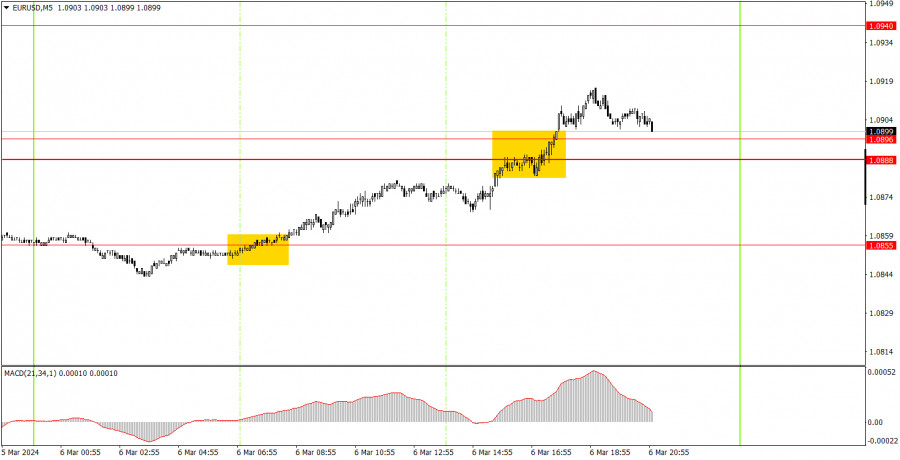

EUR/USD showed positive trades on Wednesday. Volatility slightly increased but remained far from normal levels. It's important to understand that the price moved about 70 pips from the day's low to the high, given a relatively strong fundamental and macroeconomic background. The U.S. released two interesting reports, and Federal Reserve Chairman Jerome Powell delivered a speech. Despite the fact that the U.S. reports did not show disappointing values, the U.S. dollar started to depreciate from the early morning and continued to do so in the second half of the day. Therefore, we believe that the pair's movement on Wednesday was somewhat illogical.
Nevertheless, after two weeks of a flat market, the upward trend could resume, especially around the level of 1.0880. We don't see any reason for the euro to rise further, but the market makes its own decisions. In any case, various signals are forming on the 5-minute timeframe: both for buying and selling.
EUR/USD on 5M chart
Two buy signals were generated on the 5-minute timeframe. Initially, the pair surpassed the level of 1.0855, and then the area of 1.0888-1.0906. Therefore, novice traders could open long positions at the very beginning of the European session, which should have been manually closed by the end of the day, as there were no sell signals. The profit from the trade was about 35 pips.
Trading tips on Thursday:On the hourly chart, EUR/USD left the sideways channel and seems willing to resume the upward trend, although it has no reason to do so. We still expect the euro to resume its decline, which, in our opinion, should continue for quite some time, but the market is not in a rush. On Thursday, you may consider long positions if the price does not fall below the area of 1.0888-1.0896.
The key levels on the 5M chart are 1.0568, 1.0611-1.0618, 1.0668, 1.0725, 1.0785-1.0797, 1.0855, 1.0888-1.0896, 1.0940, 1.0971-1.0981, 1.1011, 1.1043, 1.1091. On Thursday, the EU's docket will feature the results of the European Central Bank meeting and a speech of the ECB's President Christine Lagarde. Both of these events can trigger a strong and not necessarily logical market reaction. However, in any case, they will influence trader sentiment. There will be few important events in the U.S., and all the most interesting events are planned for Friday.
Basic trading rules:1) Signal strength is determined by the time taken for its formation (either a bounce or level breach). A shorter formation time indicates a stronger signal.
2) If two or more trades around a certain level are initiated based on false signals, subsequent signals from that level should be disregarded.
3) In a flat market, any currency pair can produce multiple false signals or none at all. In any case, the flat trend is not the best condition for trading.
4) Trading activities are confined between the onset of the European session and mid-way through the U.S. session, after which all open trades should be manually closed.
5) On the 30-minute timeframe, trades based on MACD signals are only advisable amidst substantial volatility and an established trend, confirmed either by a trendline or trend channel.
6) If two levels lie closely together (ranging from 5 to 15 pips apart), they should be considered as a support or resistance zone.
How to read charts:Support and Resistance price levels can serve as targets when buying or selling. You can place Take Profit levels near them.
Red lines represent channels or trend lines, depicting the current market trend and indicating the preferable trading direction.
The MACD(14,22,3) indicator, encompassing both the histogram and signal line, acts as an auxiliary tool and can also be used as a signal source.
Significant speeches and reports (always noted in the news calendar) can profoundly influence the price dynamics. Hence, trading during their release calls for heightened caution. It may be reasonable to exit the market to prevent abrupt price reversals against the prevailing trend.
Beginning traders should always remember that not every trade will yield profit. Establishing a clear strategy coupled with sound money management is the cornerstone of sustained trading success.